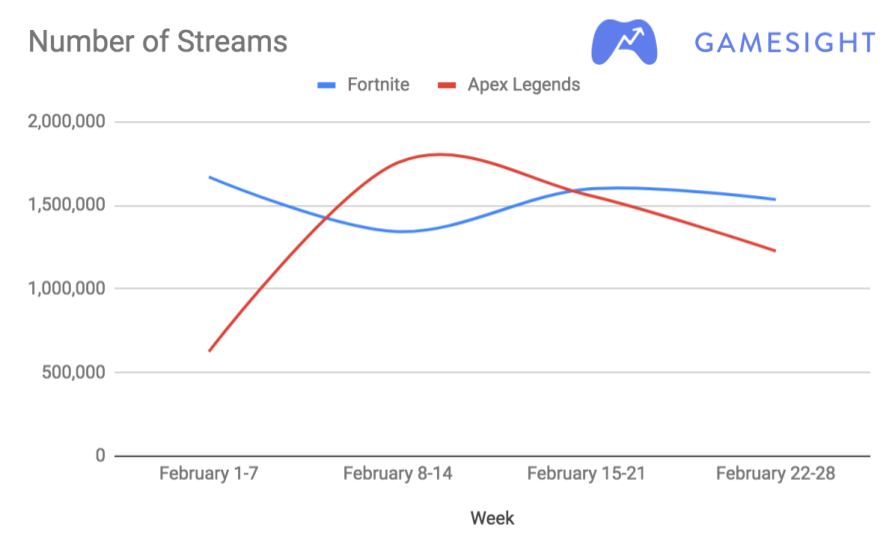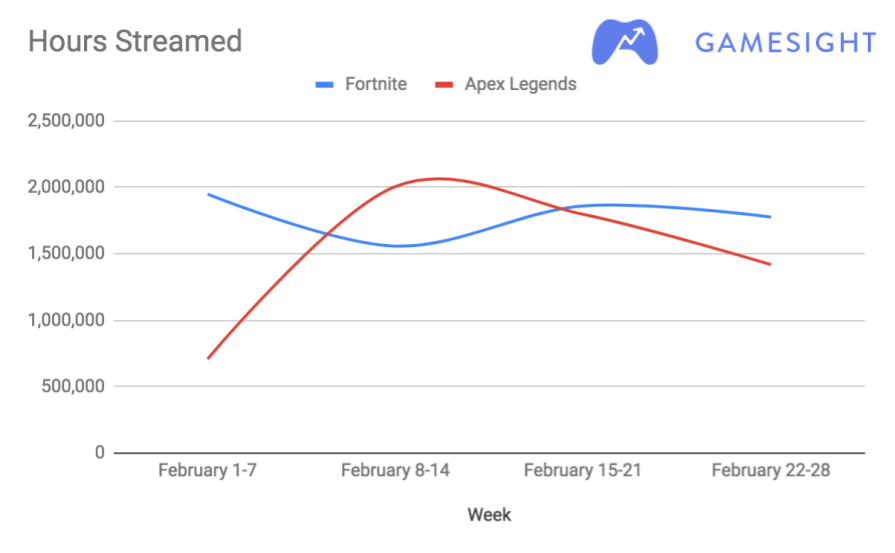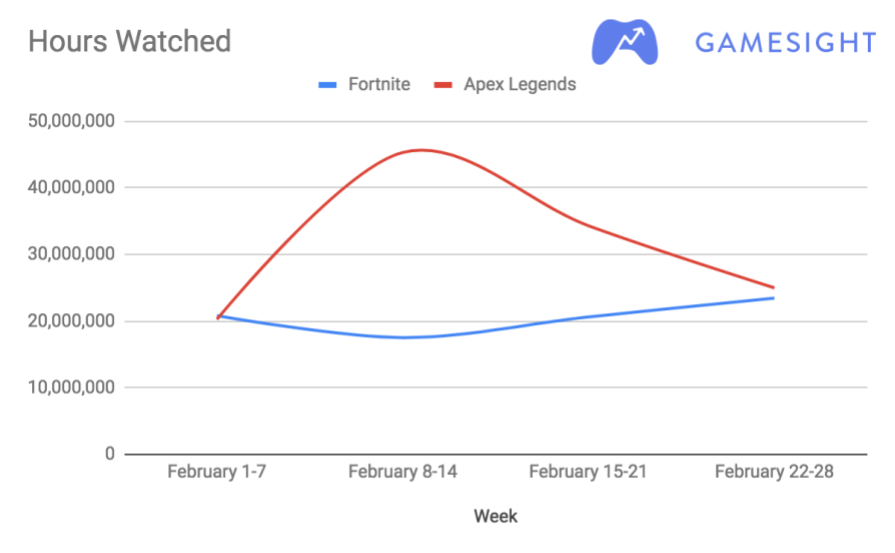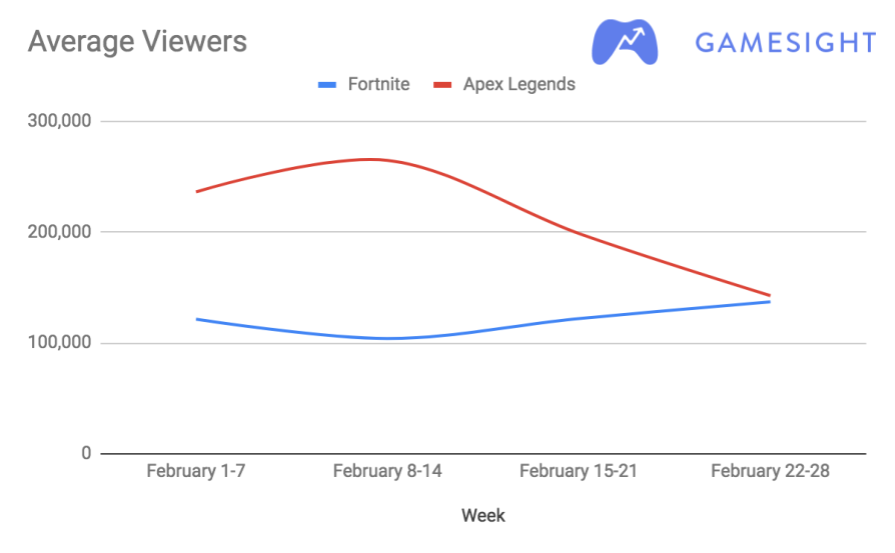Can Fortnite Respawn, or will Apex Legends maintain its Epic rise?

While the next few months should give us a better idea of the new normal, the competition between Apex and Fortnite seems to be reaching a kind of equilibrium on Twitch. Neither necessarily has the upper hand, as Fortnite continues to gain back momentum and Apex starts to stabilize after its initial two weeks of huge growth.
After a year of Fortnite dominating the battle royale genre, Apex burst on the scene early in February, to much fanfare and whispers that it would be the one to dethrone Epic's powerhouse. Prior to Monday, February 4th, we had very little information about Respawn's impending release. The rumors flew, but nothing concrete had been released by the studio behind the Titanfall franchise.
To say that Apex's launch was unprecedented is an understatement. Apex launched from a place of extreme secrecy with incredible precision. A short developer stream and trailer introduced the free to play battle royale set in the Titanfall universe, followed immediately by not only the release of the game, but a massive paid influencer campaign which saw most of the top live streamers showcasing the fast-paced shooter's often explosive gameplay. These tactics saw Apex reach milestones in days that took Fortnite, its main rival and 2018 powerhouse, months to achieve.
Apex rose to the top of the Twitch charts almost immediately and did not let go throughout its first two weeks. While Fortnite, League of Legends, and Overwatch have all had their moments on top, Apex has been the dominant force on Twitch during February, and it seems to be poised to stay a contender over the long term.
Apex by the Numbers

Since its release, Apex has generated more than 122 million viewer hours watched, while averaging more than 200,000 viewers at any given time. During that same period, as the graph above indicates, it has spent much of its time in the number one spot on Twitch.
For context, Fortnite has generated just over 71 million viewer hours watched and averaged around 118,000 viewers at any given time over the same time period. Additionally, in the three weeks leading up to Apex's release, Fortnite only generated 79 million viewer hours watched, and averaged just over 156,000 viewers at any given time.
While this is certainly impressive, and it seems like Apex had Fortnite's number during February, these numbers don't tell the whole story. In addition to the Apex being new and shiny, Apex's rise is also at least in part based on a brilliant influencer campaign by its publisher EA, and a much hyped Twitch Rivals tournament which took place the week after its launch, attracting some of the top streamers playing for glory and a prize pool of $100,000.
With February now done, we wanted to take a deeper look at the battle between the titan and the young upstart for the Twitch crown. What we found was interesting, to say the least.
We started by looking at the streamers

We began by looking at the what the content creators were doing. First, we looked at how many streams there were for each game for the full month. Apex rose from just over 625,000 streams in its first short week to 1.7 million by week two. However, beginning in week three, the number of Apex streams began to fall, with its final week down to 1.2 million.
As Apex was rising, Fortnite's stream numbers fell from 1.67 million in week one, to just 1.3 million in week two. However, Apex's constriction also coincided with a boost to Fortnite's numbers, settling between 1.5 and 1.6 million streams in weeks three and four.
The number of stream hours follows similar trajectories.

This seems to indicate that Apex's fast start, with its launch hype, campaign, and initial tournament, did affect Fortnite's numbers somewhat. Looking at individual streamers, it was able to pull some streamers away from Fortnite initially, but many have returned to Fortnite as part of their rotation, allowing Fortnite to recover and stabilize.
Also interesting is the fact that even though Apex gained the top spot following its launch, in terms of total numbers, Fortnite did edge it out in streams, hours streamed, and unique streamers during February. Since Apex's launch, Fortnite had over 1 million unique content creators stream their game on Twitch to Apex's 823,000.
What this tells us is that Fortnite's player base is more broad and stable than Apex's base so far, allowing Fortnite to maintain a strong foundation, even while weathering the ups and downs of new game releases.
Additionally, Apex drew on a number of genres to make up its player base, including a strong contingent of variety and shooter streamers. Of the total streamer base for Apex, only about 33% of those who streamed Apex in the first two weeks had been primarily Fortnite streamers previously. This meant that Apex's numbers were actually bolstered by not having to take as large a share from Fortnite's streamer base, who have proven themselves fairly loyal.
When looking at all of these things in context, it seems the most likely outcome from a streamer side perspective is a kind of tentative equilibrium, with Apex finding its place, and Fortnite continuing to ride its solid, loyal foundation.
Things really get interesting on the viewer side.
While the streamer side of things has been up and down for both games, the viewer side presents a much more volatile and interesting world.

Streamer numbers certainly tell one part of the story, but the real power of Twitch is in the audience, and the audience has shifted significantly during the month of February, to and then away from Apex.
In its first short week, Apex was only 600,000 viewer hours away from catching its rival, even with Fortnite having three additional days of content. Meanwhile, in the second week, Apex dominated, producing 45 million viewer hours to Fortnite's 17 million. The fact that this was only a 3 million hour dip for Fortnite, speaks to Apex's ability to draw viewership from other genres.
However, in weeks three and four, Apex viewership has steadily fallen, while Fornite's is on the rise. If the trends continue, Fortnite will pass Apex this week.
The average viewer numbers are equally interesting:

Average viewer count in this context is the average number of viewers for the game at any given time. Apex maintained a higher average viewer count throughout the month of February, but as with viewer hours, the two games are poised to make a switch in the coming week.
So, if Fortnite retained a significant number of its streamers, and in fact drove more streamers and stream hours during February, why then was Apex so dominant on the viewer side in its first two weeks, and falling so significantly in the last two? The answer seems to be found by looking at the viewership being generated at the individual streamer level.
Of the 122 million viewer hours generated by Apex since its launch, over 29 million (23%) are attributable to its top five streamers: Shroud (14.2m), DrDisrespect (4.1m), Ninja (4m), TimTheTatman (3.4m), and Summit1g (3.3m).
Another 10 million is attributable to the next five streamers. So 32% of viewer hours is attributable to the top ten Apex streamers.
When we look specifically at the top five, Apex has accounted for a significant portion of their recent streaming: Shroud (77%), DrDisrespect (80%), Ninja (60%), TimTheTatman (67%), and Summit1g (63%). Fortnite does not appear in either Shroud's or Summit1g's top streamed games at all. For the other three, it has been reduced to a minority: DrDisrespect (2.7%), Ninja (33%), and TimTheTatman (11%). Additionally, Ninja and TimTheTatman had been Fortnite's number 4 and 5 performing streamers respectively the three weeks prior to Apex's launch.
Meanwhile, for Fortnite, its top five streamers generated about 14 million of its 71 million viewer hours (20%). Its top ten makes up about 30% of its overall viewer hours since Apex's launch. Of those top 10, four spend over 90% of their time on stream playing Fortnite, while two (Ninja and Gotaga) spent more than half their time playing Apex. This indicates that not only is Fortnite's audience somewhat more spread out, its top tier is very dedicated to the game.
So, while the difference in the proportion of viewer hours coming from the top streamers is only 2-3%, top streamers simply drove more audience to Apex during the same period. Shroud's 14 million viewer hours for Apex is over double Tfue's 5.8 million for Fortnite. Indeed of all the Fortnite streamers, only Tfue's numbers would have cracked the top 6 on the Apex charts.
Additionally, their shared top streamers are instructive, as both have a significant affect on the viewer numbers for each game. Ninja was number three for both Apex and Fortnite since Apex's launch. Gotaga sat at number 7 for Apex and number 8 for Fortnite. Ninja drove 4 million viewer hours to Apex and only 2.1 million to Fortnite. Similarly, Gotaga drove 2.1 million viewer hours to Apex and only 1.4 million to Fortnite.
So, when putting all the data together, it seems that Apex's viewer win in February comes down to simply being more effective in driving viewership per streamer than Fortnite.
This disparity is likely the result of the initial hype of the launch naturally drawing in a surge of viewers followed by a tournament that drew a lot of attention across Twitch. Additionally, it may be that this bump in viewership caused streamers to stream for longer hours to increased audiences making for higher than usual hours watched. With these things in mind, it seems that Fortnite didn't really suffer as much as Apex benefitted from an excellent launch.
So the big question: will Fortnite reclaim its top spot or will Apex buck the trend and fend them off over the long term?
Answer: Fortnite is likely going to take over the top spot at least in the short term.
However, as things progress, we anticipate that Apex isn't going anywhere, and that it will continue to give Fortnite a run for its money in the long term.
First, Apex has been quite effective at pulling in streamers from various games and genres. While Apex would be hurt by certain community members returning to Fortnite, many of its biggest streamers are not likely to boost the Fortnite numbers any time soon. While Fortnite has gain audience share back at the same time that Apex stabilizes as the hype settles, its quite likely that this is not a zero sum game between the two. Apex's fall will level off. At that point, both can continue to grow without cannibalizing the other.
Second, Fortnite has a strong foundation on the streamer side, allowing to weather challenges from newcomers. Apex presented the best challenge we've seen, and Fortnite only missed the slightest of beats. That strong foundation isn't going anywhere any time soon. That gives Fortnite the ability to maintain its top spot even if Apex turns the trends around.
Third, they are very different games. Fortnite's cartoonish art style, zany emotes, and overall upbeat atmosphere have made it a mainstay in popular culture. It's fun to play, fun to watch, and appeals to a very wide demographic. Apex Legends, meanwhile, is fast-paced (sometimes frantic) and very competitive in its sensibility. There's very little that is cartoonish about it. This is likely why it has had so much appeal across so many different genres.
As we continue to watch these two over the next few months, a new normal will almost certainly emerge. What we do know is that neither of these games is going away any time soon.
Follow us on Twitter and LinkedIn for all the latest blogs, announcements, and game marketing news from the team at GAMESIGHT!

